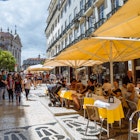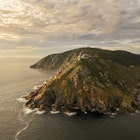
Why you should choose the Portuguese Way for your Camino de Santiago

Oct 24, 2023 • 5 min read

Yearly, thousands of people of various backgrounds walk the Camino de Santiago either on their own or in organized groups © Ana Fernandez/SOPA Images/LightRocket via Getty Images
Almost two years after I completed it, my mind frequently wanders back to my time on the Portuguese Way of the Camino de Santiago.
Before you start planning, you can be certain that you’ll never be able to forget this journey.
A storied and unforgettable route
The Camino de Santiago is a pilgrimage to what is believed to be the final resting place of St James the Apostle in Santiago de Compostela, Spain. For centuries, religious pilgrims have followed the Way of St James in search of spiritual fulfillment. Today, people have a wide variety of reasons for taking on these hundreds of kilometers by foot, from weight loss to a simple desire to slow down and be more mindful.
- placement: fullWidth
- path: articles/in-content-top
- possible size: [970, 250], [970, 90], [728, 90], [300, 250], [320, 50], [1, 1],
- targeting:
{ "url": "why-choose-portuguese-way-camino-de-santiago", "destination": "Portugal", "continent": "Europe", "country": "Portugal" }
There are many paths to get to Santiago. I took the 260km (161-mile) journey between Porto and Santiago, allowing me to see villages in both Portugal and Spain along the way.
When my thoughts drift to my epic adventure – which I did as a solo traveler – I’m flooded with many feelings all at once. I think about the luxury of waking up each day with my sole task simply walking to the next gorgeous town and enjoying the scenery, from the stunning Portuguese coast to Roman bridges. How when I walked through the vineyards of one stretch of the Camino, I heard a choir singing.

Then there are the people I met along the way. The three brothers from Colorado who kept me laughing the first half of the trek, who were walking to celebrate the middle brother’s 60th birthday. The Australian family with whom I enjoyed a bottle of wine and steak dinner on a patio in Pontevedra on our rest day. I remember turning the corner and spotting a retired couple from the UK I had met at one of the guesthouses now having a coffee on a restaurant terrace and thinking to myself, Well, where else do I have to be? – before joining them.
All at once, I’ll hear the melody of the bagpipes that suddenly appeared on one trail. Or get emotional picturing the unexpected beauty of towns like Ponte de Lima and Valença, which now hold tender spots in my heart. The wonder of buying cookies from cloistered nuns in Tui. The pride I felt when I took a photo of my feet straddling the border between Spain and Portugal – realizing how far I had come and yet how far I still had to travel.
For two weeks, my mind stilled into a sort of meditative state, free from the anxiety that normally buzzes through my head. It was one of the hardest things I have ever done – but it also filled me with so much peace that I yearn to get back. When the nostalgia sweeps over me, a new question rattles in my mind.
Should I do it again?
Why you should choose the Portuguese Way
You’re probably here because you spotted this on the 2024 Best in Travel and are wondering if you should do it, too.
- placement: fullWidth
- path: articles/in-content-middle
- possible size: [970, 250], [970, 90], [728, 90], [300, 250], [320, 50], [1, 1],
- targeting:
{ "url": "why-choose-portuguese-way-camino-de-santiago", "destination": "Portugal", "continent": "Europe", "country": "Portugal" }
This year, more than 337,000 pilgrims have walked the Camino already, with more than 100,000 of them taking the Portuguese Way. The French Way is the longer, more popular route, the one you see in all the movies like The Way with Martin Sheen. It’s also nearly 800km (500 miles) long.
This is why I’m thrilled that the second-most-popular (and less crowded) route was selected to for Lonely Planet’s 2024 Best in Travel list for sustainability.

Here’s my brief case for why the Portuguese Way is the best choice for your Camino journey.
First, traveling from Porto to Santiago de Compostela takes about two weeks, give or take a couple of days depending on your pace. This scale makes tackling the entire distance achievable within the span of one vacation. (Though the entire French Way takes a time commitment of more than a month, it’s very common for people to join midstream on the trail to cut down on time and mileage. It’s your Camino, after all, and the only requirement to get the Compostela is you must complete the last 100km on foot.)
Second, the Portuguese Way lets you take in life far from the cities, in two different countries. While fewer crowds join this trail, you’ll still find a robust number of pilgrims making their way to Santiago – allowing you to soak in the famous sense of camaraderie and community without feeling overwhelmed.
This medieval route was sustainable long before that was a trend. You’ll be on foot (or bike) the entire time, and as you pass through the small towns along the way, you’ll be supporting communities that have seen their populations decline as people drift toward bigger cities.
- placement: native
- path: articles/in-content-native
- possible size: [f, l],
- targeting:
{ "url": "why-choose-portuguese-way-camino-de-santiago", "destination": "Portugal", "continent": "Europe", "country": "Portugal" }
Along with sustainability for the planet, by supporting small businesses the trip is also sustainable for your wallet. My two-week trek cost me a little over $1230, in addition to my plane ticket.
Finally, I can’t emphasize enough what this trip will do for your brain. Yes, it is physically hard – but mentally fulfilling, as you slow down and just enjoy the journey.
Want to choose a different path? Find out which Camino is right for you.

Planning my return to the Camino
When I started formulating my itinerary (which you can read more about here), I was struck by how many people returned to repeat the grueling trek two, three or four more times. Before I had set out, that seemed bananas to me.
Now, I totally get it.
I recently checked in with several other friends who had recently completed Caminos, including Joe Sills (who shared this account of the Variante Espiritual portion of the Portuguese Way). Everyone had their own cherished memories of the journey, and I was surprised how many told me that they, too, were pondering when and how they might do it again.
If you set out yourself, you’ll surely never forget your slow journey along the cobblestone trails, the delicious food and wine you’ll drink, and the people you’ll meet. And you’ll surely start dreaming of doing it all over again.
Consider yourself warned.
- placement: fullWidth
- path: articles/bottom
- possible size: [970, 250], [970, 90], [728, 90], [300, 250], [320, 50], [1, 1],
- targeting:
{ "url": "why-choose-portuguese-way-camino-de-santiago", "destination": "Portugal", "continent": "Europe", "country": "Portugal" }
Explore related stories



 Art and CultureCopy my trip: An unforgettable family trip to Spain with Elsewhere by Lonely Planet
Art and CultureCopy my trip: An unforgettable family trip to Spain with Elsewhere by Lonely PlanetNov 19, 2024 • 4 min read




 National Parks8 things to do in Northwest Spain - beyond hiking the Camino de Santiago
National Parks8 things to do in Northwest Spain - beyond hiking the Camino de SantiagoNov 6, 2024 • 9 min read

